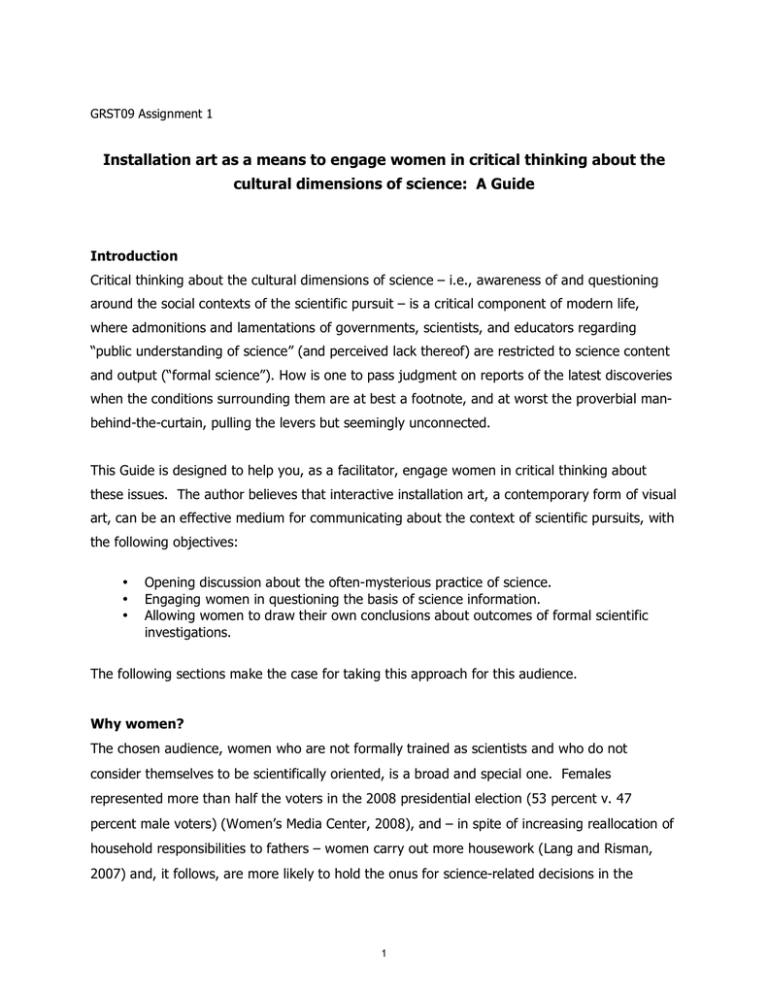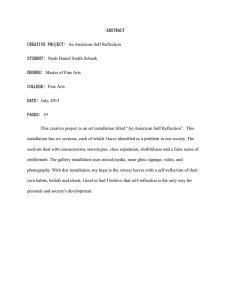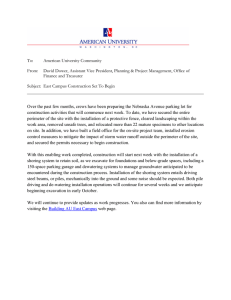Installation art as a means to engage women in critical... cultural dimensions of science: A Guide
advertisement

GRST09 Assignment 1 Installation art as a means to engage women in critical thinking about the cultural dimensions of science: A Guide Introduction Critical thinking about the cultural dimensions of science – i.e., awareness of and questioning around the social contexts of the scientific pursuit – is a critical component of modern life, where admonitions and lamentations of governments, scientists, and educators regarding “public understanding of science” (and perceived lack thereof) are restricted to science content and output (“formal science”). How is one to pass judgment on reports of the latest discoveries when the conditions surrounding them are at best a footnote, and at worst the proverbial manbehind-the-curtain, pulling the levers but seemingly unconnected. This Guide is designed to help you, as a facilitator, engage women in critical thinking about these issues. The author believes that interactive installation art, a contemporary form of visual art, can be an effective medium for communicating about the context of scientific pursuits, with the following objectives: • Opening discussion about the often-mysterious practice of science. • Engaging women in questioning the basis of science information. • Allowing women to draw their own conclusions about outcomes of formal scientific investigations. The following sections make the case for taking this approach for this audience. Why women? The chosen audience, women who are not formally trained as scientists and who do not consider themselves to be scientifically oriented, is a broad and special one. Females represented more than half the voters in the 2008 presidential election (53 percent v. 47 percent male voters) (Women’s Media Center, 2008), and – in spite of increasing reallocation of household responsibilities to fathers – women carry out more housework (Lang and Risman, 2007) and, it follows, are more likely to hold the onus for science-related decisions in the 1 household, everything from whether to purchase antibacterial soap to assessing the risks and benefits to their daughters of the vaccine against HPV (human papilloma virus, one cause of cervical cancer). At the same time, women are more likely to report discomfort with science content, and their perception of the culture of science elicits awe or fear rather than questioning (Barr and Birke 1998, p.50; Haynes 1994). In reality, women already hold science knowledge, yet it is not recognized as such by society (see e.g., Hackett et al., pp. 516, 620), or even by the women themselves (Barr and Birke, 1998, p.49). Once women realize that they hold this knowledge, they are empowered for giveand-take with the existing power structure around science (Barr and Birke, 1998, p.139). Why art? Visual art is a logical means for engaging new audiences in questioning the culture of science. Arnheim (1977) asserts that “truly productive thinking in whatever area of cognition takes place in the realm of imagery” (p.v). Stephen Pinker (1997) explored vision as a cognitive practice, stating that interpretation of visual cues cannot happen without integrated and advanced cognition (pp 294-298). Visual cues are universal and can be archetypal. In a classic art text, “Ways of Seeing” (Berger, 1977), details visual codes carried through Western art and into modern advertising that call up universal messages.1 These messages are even more commonly delivered to our contemporary media-saturated public. Some examples (and classic art-history examples) relevant to our topic: “The romantic use of nature (leaves, trees, water) to create a place where innocence can be refound. [sic] The poses taken up to denote stereotypes of women: serene mother (madonna), free wheeling [career woman] (actress, king’s mistress), perfect hostess (spectator-owner’s wife), sex object (Venus, nymph surprised), etc. The sea, offering a new life. The treatment of distance by perspective – offering mystery.” (Berger, 1977, p.138) 1 See this excerpt from the BBC series on which the book is based: http://www.youtube.com/watch?v=6q0JvXiZw7o 2 Arnheim, in his book “Visual Thinking” (1969), demonstrates that even those without formal art training are able to illustrate concepts visually. For example, student-subjects came up with multiple ways to communicate the concepts of past, present, and future; and democracy (pp.121-129). What would happen if we asked women to illustrate the concept of science? Why installation art? Installation art is a form of visual art constructed in and for a specific setting. It has been put into use for political statements about the status of women (e.g., Judy Chicago et al., Womanhouse, 1972, as described by Princethal, 2008), and challenges to the art establishment (Reiss, 2001, pp 110 et seq.). The actual form and materials of a given installation art is up to the artist, and a broad range of materials and styles have been employed (Princethal, 2008), but installation art by definition requires some interaction between the art and the viewer – a requirement that is not true of classroom teaching, theatre, demonstration, or even performance art, a close cousin of installation art. In her ground-breaking history of the genre, Reiss (2001) explains The essence of Installation art is spectator participation… Participation can mean offering the viewer certain activities…demanding that the viewer walk through the space and simply confront what is there. Objects may fall directly in the viewer’s path or become evident only through exploration of space. In each of these situations, the viewer is required to complete the piece; the meaning evolves from the interaction between the two. (p.xiii) If accessible (both in situation and language – i.e., not laden with too much jargon, visual or otherwise), then installation art’s mode of engagement lends itself well to the problem at hand, engaging women in new perceptions of and critical thinking about the culture of science. Examples This section provides a personal example of installation art for non-scientific audiences, and three disparate approaches by artists that can serve as sources for the design of a new model for engaging women in critical discussion of the culture of science. Body Maps. This project, modeled after one in Africa for HIV-positive women (http://www.catie.ca/bodymaps/gallery.shtml), encourages women to reclaim knowledge of 3 their own bodies. The author, faced with a diagnosis that only showed up through scientific imaging (i.e., not any illness physically felt), led a group of women in Arlington as they took away canes, wore purple dresses, and illustrated medical “miracles” on larger-than-life size canvasses. Critical Art Ensemble (CAE; http://www.critical-art.net). This group of five artists “of various specializations” entered the national news when one of their number, Steve Kurtz, was arrested by the FBI under suspicion of terrorism – when he called 911 to report the death of his wife, agents found test tubes and microbial cultures in his home refrigerator related to a CAE experiment. The collective’s work includes “tactical media” (“situational, ephemeral, and selfterminating communications”), street installations, and electronic and paper publications, all produced with the “hope to replace general fear with critical tools and replace public impotence with tools for direct action.” I have not been able to assess the effectiveness of this approach to date – their single You Tube video has fewer than 400 views. Capacitor (www.capacitor.org). This San Francisco-based dance company interprets science content through dance. This troupe has its own audience, whom I presume is more interested in dance than science – so it is unclear whether they meet their statement of purpose: By engendering dialogue around contemporary technological and scientific issues, the resulting performance piece is not meant to be true to science or demonstrative, but a creative response to the issues and ideas explored by the participants. New directions Several concepts of the culture of science lend themselves to installation, for example: • The places and spaces of scientific practice (Henke and Gieryn, 2008). • The political demands on applied science (e.g., federal and state regulatory agencies’ requirements for data-gathering). • Visualization of scientific information (Burri and Dumit, 2008). We can take lessons from art criticism and studies of visual cognition as we design art installations for women on the culture of science. The components of an installation need not be abstracted or coded into oblivion, never to be understood by an audience unfamiliar with art history or art criticism. Sources and Resources Arnheim, Rudolf (1969). Visual Thinking. Berkely: University of California Press. 345pp Berger, John (1977). Ways of Seeing. London: British Broadcasting Corporation. 166pp 4 Barr, Jean and Lynda Birke (1998). Common Science? Women, Science, and Knowledge. Bloomington IN: Indiana Press. 166pp Burri, Regula Valerie and Joseph Dumit (2008). “Social studies of scientific imaging and visualization.” pp 297-318 in Hackett et al., 2008 Hackett, Edward, Olga Amsterdamska, Michael Lynch, and Judy Wajcman (2008). The Handbook of Science and Technology Studies (3rd Ed.). Cambridge: MIT Press. 1065pp Haynes, Rosslyyn D. (1994). From Faust to Strangelove: Representations of the Scientist in Western literature. Baltimore: Johns Hopkins University Press. as cited in Barr and Birke (1998) Henke, Christopher R. and Thomas F. Gieryn (2008). “Sites of scientific practice: the enduring importance of place.” pp 353-376 in Hackett et al., 2008 Lang, Molly M. and Barbara J. Risman (2007). “A ‘Stalled’ Revolution or a Still-Unfolding One? The Continuing Convergence of Men’s and Women’s Roles.” accessed 2/7/2009 from http://www.contemporaryfamilies.org/subtemplate.php?t=briefingPapers&ext=stalledrevolution. Princethal, Nancy (2008). "Installation Art," Microsoft® Encarta® Online Encyclopedia accessed 2/25/09 Pinker, Steven (1997). How the mind works. New York: WW Norton and Co. 660pp Reiss, Julie H. (2001). From Margin to Center: The Spaces of Installation Art. Cambridge MA: MIT Press. 181pp Women’s Media Center (2008). [http://www.womensmediacenter.com/ex/110608_a.html] 5 MIT OpenCourseWare http://ocw.mit.edu WGS.693 Gender, Race, and the Complexities of Science and Technology: A Problem-Based Learning Experiment Spring 2009 For information about citing these materials or our Terms of Use, visit: http://ocw.mit.edu/terms.





